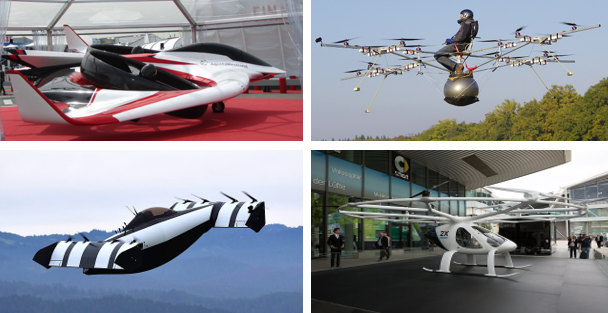eVTOL Aircraft: Shaping The Future Of Urban Air Mobility
- Muhammad Ahnuf

- Jan 24, 2021
- 3 min read
This blog discusses about the trending eVTOL aircraft technology and it's tremendous potential to revolutionize the air transport industry.

About eVTOL Aircraft
The electric vertical takeoff and landing (eVTOL) aircraft is considered to be the future solution to our transportation needs. The spider-looking multi-rotor aircraft has the combined ability of an aircraft and a helicopter. The primary feature of this staggering new technology is that it uses electric power to take-off & land vertically. Moreover, it has the added ability to hover as well, which adds to its dynamic abilities.
Promising Technology
Companies around the globe believe eVTOL aircraft has the potential to unlock potential in urban areas in ways a traditional aircraft simply can’t. Some major benefits include added maneuverability, efficiency, noise reduction and environmental improvements. Hence, a latest generation of innovators such as engineers, technologists and programmers are working on more than 250 advanced eVTOL concepts in an effort to bring Urban Air Mobility (UAM) to reality.
With a strong sense of optimism to connect cities, regions autonomously a slew of fixed wing, multi-rotor and tilt-wing air taxi concepts loaded with cameras, sensors and radars are under development. Many eVTOL’s being developed are awaiting certification, whereas others are in pursuit of completion.

First Interest
The concept of electric vertical takeoff and landing aircraft (eVTOL) emerged back in 2011 from the AugustaWestland Project Zero (USA), Opener BlackFly (USA) and the Volocopter VC1 (Germany). The eVTOL concept was officially introduced by the American Helicopter Society (AHS) which is now known as the Vertical Flight Society (VHS) and the American Institute of Aeronautics & Astronautics (AIAA) in 2014 during a Vertical Flight Concepts workshop held in Virgina (USA).

Uber Takes Interest
The American ride-sharing giant, Uber Technologies Inc. took interest in the ever-rising eVTOL aircraft technology when it developed Uber Elevate, a concept for an intraurban air taxi service which uses vertiports on its rooftops. In the beginning of 2020, Uber shortlisted eight potential eVTOL partners as candidate designs:
Bell Nexus
Aurora Flight Sciences
Embraer’s EmbraerX
Joby Aviation S4
Hyundai Motor Company’s S-A1
Karem Aircraft Inc. Butterfly OSTR
Jaunt Air Mobility
Pipistrel 801


According to Uber, FAA noted that certified and piloted eVTOL aircraft can operate safely within the national airspace without any need for changes to the system today. Thus, Uber is working on certifying its vehicle partners and the FAA on certification of pilots.
Although Uber looks in pursuit to revolutionize the public transport, it took a massive hit during the pandemic in 2020, closing 40 offices and shedding more than 7000 jobs.
Uber Inc. Hits The Headlines
The headline-grabbing news came in December 2020 when Joby Aviation, a California based all-electric vertical takeoff and landing aircraft company acquired the Uber Elevate project. Uber technologies announced that they will be investing $75 million in Joby Aviation along with the previously undisclosed $50 million investment in January 2020. This move will enable Joby to use Uber’s app to offer air taxi rides when the company’s aircraft eventually enters service. This could as early as 2023.

eVTOL Challenges
Initially the eVTOL aircraft concept comprised of electric batteries running the aircraft. Moreover, Uber also said that it plans to use a fleet of aircraft that is all electric, this meant that electric motors will power the aircraft’s rotors. However, the power source to drive these motors aren’t mentioned. The present assumption is that lithium-ion batteries will be used as a power source. Although lithium batteries has its benefits, but its drawbacks are unacceptable in aviation applications. Some key drawbacks include:
Limited endurance due to their low energy density.
Impractical to use in rotorcrafts as it consumes lot of power in vertical flight.
Lithium batteries are very heavy and weight the same when they are full as they are empty.
They don’t perform well in cold environments, above 12000 ft.
Long charging times.
Lithium batteries require thermal protective casing due to possibility of thermal runaways.
Practical Solution
According to several energy and aerospace companies, the best possible solution to eVTOL propulsion systems is the use of Hybrid-electric powered systems.
Some companies such as Bell’s Nexus offer a hybrid power arrangement to enhance range and power of the eVTOL aircraft. The hybrid system includes the use of an internal combustion engine as well as batteries. The power produced is used to drive the aircraft rotors along with charging its batteries. Moreover, the power can be utilized by pilots during takeoff and landing phases as well. The most recent development is the Pipistrel’s Panthera low wing single aircraft.

I will conclude by saying that eVTOL aircrafts are surely the future of Air Mobility Transport and with the integration of hybrid-electric propulsion systems they can become a reality very soon!
Blog Sources (Wikipedia, Uber.com, FAA, evtol.news)
.png)






Comments